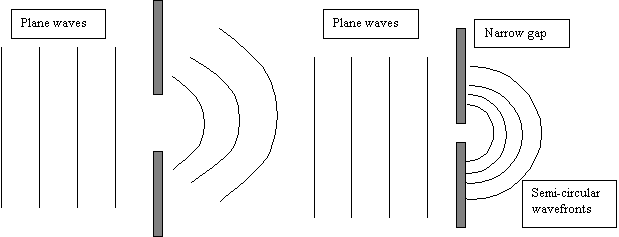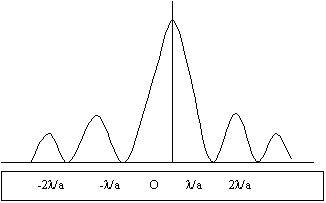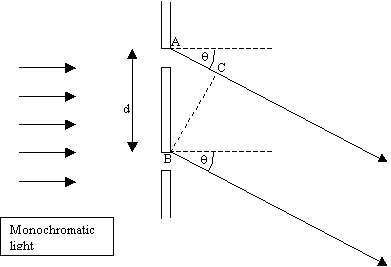
Diffraction is the
spreading of waves as they pass through an opening or round an obstacle into
regions where we would not expect them.
Diffraction of water waves is seen using a ripple tank.

The greatest
effect is seen when the gap is comparable to the wavelength of the waves and
diffraction of the wavefronts extends completely into the geometrical shadow
(i.e. the slit behaves as a point source).
If a point source of
light is observed through a single narrow slit a pattern is observed consisting
of a central band of light with bands of light on either side. The bands become
dimmer the further they are from the centre. The bands of light get closer
together as the colour of the light changes from red to green to blue.
1.
How does the separation of the
bands vary with frequency of light?
The pattern can be
accounted for by considering Huygens construction. We consider each point in the
aperture through which the waves pass to be made up of point sources each of
which produces secondary wavelets, which then spread out and interfere with each
other.
DIFFRACTION INVOLVES
SUPERPOSITION OF WAVELETS FROM DIFFERENT PARTS OF THE SAME WAVEFRONT.
The
diagram below helps to explain the single slit pattern of light and dark bands.

Consider the single slit to be made up of two strips, each half the width of the slit. A secondary source in one half has a corresponding source in the other half (A1 and A2 in the diagram are a corresponding pair). Wavelets from corresponding pairs of sources always arrive in phase at O and so a bright fringe is observed. Now consider point P. For a dark fringe to be seen at P wavelets from corresponding pairs of sources must arrive at P exactly half a wavelength out of phase so that they cancel each other.
If
q is
the direction of the minima, l is
the wavelength and a is the width of the slit it can be shown that
sin q
= l
a
Background
reading : Breithaupt p269-276

The
intensity of the bands on either side of the central band are approximately 5%
or less of the intensity of the central band.
If
the number of slits is increased then each slit produces a diffraction pattern
and also there is interference between the diffraction patterns of each slit.
The resulting pattern is one of bright and dark fringes which decrease in
intensity with distance from the central maximum.
In
principle the diffraction grating is a large number of narrow, parallel,
equidistant slits. It is usually made by scoring lines on glass using a fine
diamond point. The lines scatter the incident light and behave as though they
are opaque while the spaces between them transmit light and behave as slits.
Diffraction
gratings are usually quoted in terms of the number of lines per metre. The
grating spacing is therefore the inverse of this value.
Example
: A grating has 2000 lines per millimetre. Calculate the grating spacing.
A
fine grating (2000mm-1) produces more sharply defined spectra which
are further apart than does a coarse grating (300mm-1).
Theory
(for the diffraction grating equation)

In
the diagram d is the distance between corresponding points, A and B, in two
adjacent slits (ie. d is the grating spacing).
Consider
a wavelet leaving the top slit from point A and the bottom slit from point B.
For
constructive interference to occur in the direction q, the distance AC must be
equal to a whole number of wavelengths.
AC = nl
where
n is an integer corresponding to the order of the spectrum
Angle
ACB = 900 and so
Sin q
= AC
d
Thus,
for constructive interference
d sin q = nl
This
is the diffraction grating equation
Since
sin q can never be greater than 1, then nl
/ d can never be greater than 1.
This means that the order number n can never be greater than d/l.
a)
at what angle to the normal is the first order image ?
b)
what is the highest order in which an image can be obtained ?
c)
what is the total number of diffracted beams that can be observed with
this grating ?
A
diffraction grating produces an interference pattern with a single slit
diffraction pattern superimposed upon it. For a single slit the position of the
first minimum is given by
Sin q = l / a where a is the slit width
Thus when
Sin q = l / a = nl /d no order will be observed
The
order is said to be missing and the number of the missing order is given by
n = d / a
1.
Monochromatic light of wavelength 5.0 x 10-7 m falls normally on a
diffraction grating having 600 lines mm-1. Calculate the angular
position of the second order image.
2.
A diffraction grating has 800 lines mm-1 and is illuminated normally
by monochromatic light of wavelengths 5.6 x 10-7 m and 5.9 x 10-7
m. Calculate the angular difference between the two first order images.
3.
A parallel beam of sodium light of wavelength 5.89 x 10-7 m is
incident normally on a grating, and the first order diffraction image is formed
at an angle of of 26° 13’ with the normal. Calculate the number of lines per
centimetre ruled on the grating.
4.
A diffraction grating has 400 lines mm-1 and is illuminated normally
by monochromatic light of wavelengths 4.5 x 10-7 m and 6.0 x 10-7
m. In what respective order of image do the colours overlap, and what is the
corresponding angle of diffraction ?